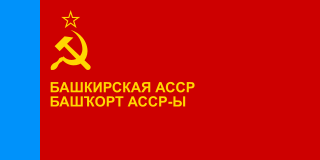
Antidepressants are a class of medications used to treat major depressive disorder, anxiety disorders, chronic pain, and addiction.
An anxiolytic is a medication or other intervention that reduces anxiety. This effect is in contrast to anxiogenic agents which increase anxiety. Anxiolytic medications are used for the treatment of anxiety disorders and their related psychological and physical symptoms.
Sri, SRI, or variations thereof, may refer to:

The Tatar Autonomous Soviet Socialist Republic, abbreviated as Tatar ASSR or TASSR, was an autonomous republic of the Russian SFSR. The resolution for its creation was signed on 27 May 1920 and the republic was proclaimed on 25 June 1920. Kazan served as its capital.

Serotonin–norepinephrine reuptake inhibitors (SNRIs) are a class of antidepressant medications used to treat major depressive disorder (MDD), anxiety disorders, social phobia, chronic neuropathic pain, fibromyalgia syndrome (FMS), and menopausal symptoms. Off-label uses include treatments for attention-deficit hyperactivity disorder (ADHD), and obsessive–compulsive disorder (OCD). SNRIs are monoamine reuptake inhibitors; specifically, they inhibit the reuptake of serotonin and norepinephrine. These neurotransmitters are thought to play an important role in mood regulation. SNRIs can be contrasted with the selective serotonin reuptake inhibitors (SSRIs) and norepinephrine reuptake inhibitors (NRIs), which act upon single neurotransmitters.
Amotivational syndrome is a chronic psychiatric disorder characterized by signs that are linked to cognitive and emotional states such as detachment, blunted emotion and drives, executive functions like memory and attention, disinterest, passivity, apathy, and a general lack of motivation. This syndrome can be branched into two subtypes: marijuana amotivational syndrome, or cannabis-induced amotivational syndrome, which is caused by usage of or dependency on that substance, and is primarily associated with long-term effects of cannabis use, and SSRI-induced amotivational syndrome or SSRI-induced apathy, caused by the intake of SSRI medication dosage. According to the Handbook of Clinical Psychopharmacology for Therapists, amotivational syndrome is listed as a possible side effect of SSRIs in the treatment of clinical depression. It is a disorder of diminished motivation.

The Soviet of the Union was the lower chamber of the Supreme Soviet of the Union of Soviet Socialist Republics, elected on the basis of universal, equal and direct suffrage in accordance with the principles of Soviet democracy, and with the rule that each deputy would represent the same number of voters. Under the 1936 Soviet Constitution, there was one deputy for every 300,000 people; this was changed by the 1977 Soviet Constitution, which provided that both chambers would have an equal number of members. Although the party gave general guidelines on nominations, such as the ratio of the social composition of the nominees, much of the work was left to local bodies and people's representatives. As opposed to the upper chamber, the Soviet of Nationalities, the Soviet of the Union represented the interests of all of the people of the Soviet Union no matter what their nationality was.

The People's Unity Party – Socialist Party, generally referred to as the Socialist Party, was an Icelandic political party that functioned from 1938 to 1968, when the People's Alliance party was created.

Supreme Soviet of the National Economy, Superior Soviet of the People's Economy, was the superior state institution for management of the economy of the RSFSR and later of the Soviet Union. There were two institutions with this name, at different times, 1917–1932 and 1963–1965.

The Bashkir Autonomous Soviet Socialist Republic, also historically known as Soviet Bashkiria or simply Bashkiria, was an autonomous republic of the Russian SFSR. Currently it is known as Republic of Bashkortostan, a federal subject of Russia. The Bashkir ASSR was the first Autonomous Soviet Socialist Republic in the RSFSR.

The Chuvash Autonomous Soviet Socialist Republic was an autonomous republic of the Russian SFSR within the Soviet Union.

The Mari Autonomous Soviet Socialist Republic was an autonomous republic of the Russian SFSR, succeeding the Mari Autonomous Oblast. When the Soviet Union disintegrated, the Mari ASSR became the Mari El Republic, a federal subject of the Russian Federation.

The Emblem of the Uzbek Soviet Socialist Republic was adopted on 14 February 1937 by the government of the Uzbek Soviet Socialist Republic. The emblem is based on the emblem of the Soviet Union. It shows symbols of agriculture and heavy industry (hammer). The rising sun over a map of the Soviet Central Asia symbolizes the future of this region, while the five pointed red star stands for the "socialist revolution on all five continents".

Indalpine, sold under the brand name Upstène, is a selective serotonin reuptake inhibitor (SSRI) that was briefly marketed as an antidepressant for treatment of depression. It was marketed in France and a few other European countries.

The Azerbaijani Soviet Encyclopedia is a ten volume universal encyclopedia published in Baku, Azerbaijan from 1976 to 1987 by the Academy of Sciences of the Azerbaijan Soviet Socialist Republic. The editors-in-chief were Rasul Rza and Jemil Kuliyev. A special volume dedicated to Azerbaijan was scheduled to be published after the main ten volumes, but due to rising political problems and difficult economic situation, it has not been released.

Talopram, also known as phthalapromine, is a selective norepinephrine reuptake inhibitor (NRI) which was researched for the management of depression in the 1960s and 1970s but was never commercialized. Along with talsupram, talopram is structurally related to the selective serotonin reuptake inhibitor (SSRI) citalopram, as well as to melitracen:
In 1971, the company hired Klaus Bøgesø as a medicinal chemist. Over the years Bøgesø turned out to have a Midas touch at the game of drug hunting, creating more molecules that made it to the market than almost any other medicinal chemist in the field. The challenge facing him in 1971 following his recruitment was to produce a selective norepinephrine reuptake inhibitor. Like other companies at the time, Lundbeck had little interest in an SSRI. Bøgesø began from an accident in the laboratory. Trying to create a derivative of their norepinephrine reuptake inhibiting antidepressant melitracen, Lundbeck chemists accidentally produced a new chemical — a phenylphthalene. Against all the odds, just like melitracen, this was also a selective norepinephrine reuptake inhibitor. Two potential antidepressants came out of this — talopram and tasulopram, which were pressed into clinical trials. Both however turned out to be energizing, and in a number of cases there were suicide attempts. The fact that there were suicide attempts appeared to confirm another proposal of Paul Kielholz, that activating antidepressants might lead to suicide. Lundbeck's experience suggested that norepinephrine reuptake inhibitors were likely to lead to just this problem. Lundbeck retreated, scared. If norepinephrine reuptake inhibitors were likely to trigger suicide, the greatest hazard of an antidepressant, then Kielholz's view suggested that an SSRI would be less likely to lead to suicide. Bøgesø's job was to see whether the new series of drugs could be converted into a series of SSRIs. Following a lead from Carlsson on how to do this, he converted talopram into citalopram, the most selective serotonin reuptake inhibitor to come to the market.

Litoxetine (developmental code names SL 81-0385, IXA-001) is an antidepressant which was under clinical development for the treatment of depression in the early 1990s but was never marketed. It acts as a potent serotonin reuptake inhibitor (Ki for SERTTooltip serotonin transporter = 7 nM) and modest 5-HT3 receptor antagonist (Ki = 315 nM). It has antiemetic activity, and unlike the selective serotonin reuptake inhibitors (SSRIs), appears to have a negligible incidence of nausea and vomiting. The drug is structurally related to indalpine. Development of litoxetine for depression was apparently ceased in the late 1990s. However, as of March 2017, development of litoxetine has been reinitiated and the drug is now in the phase II stage for the treatment of urinary incontinence.

Selective serotonin reuptake inhibitors (SSRIs) are a class of drugs that are typically used as antidepressants in the treatment of major depressive disorder, anxiety disorders, and other psychological conditions.

The State Anthem of the Azerbaijan Soviet Socialist Republic was the anthem of Azerbaijan when it was a part of the former Soviet Union. It was created in 1944 and was used from 1945 to 1992 upon the nation's independence.
Selective serotonin reuptake inhibitors, or serotonin-specific re-uptake inhibitor (SSRIs), are a class of chemical compounds that have application as antidepressants and in the treatment of depression and other psychiatric disorders. SSRIs are therapeutically useful in the treatment of panic disorder (PD), posttraumatic stress disorder (PTSD), social anxiety disorder, obsessive-compulsive disorder (OCD), premenstrual dysphoric disorder (PMDD), and anorexia. There is also clinical evidence of the value of SSRIs in the treatment of the symptoms of schizophrenia and their ability to prevent cardiovascular diseases.














